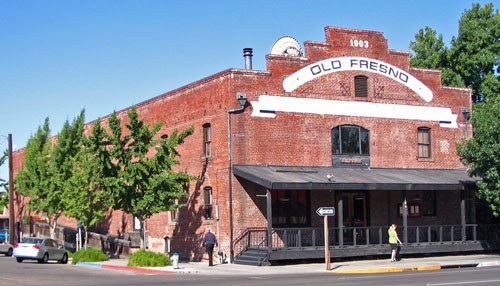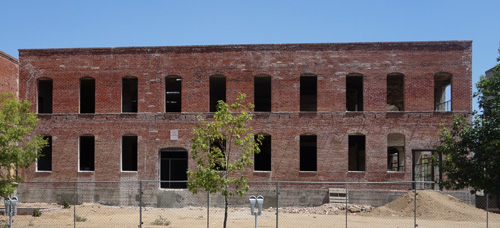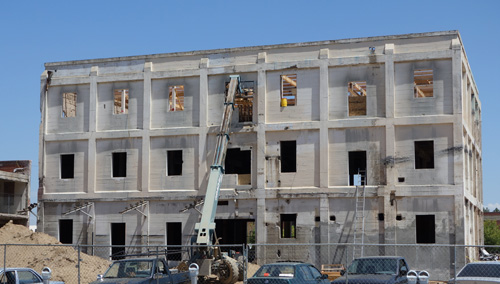Warehouse Row Buildings
Wormser Building (1909)
764 P Street
Industrial Brick, Period Revival influence
Western Meat Company (1910)
754 P
Street
Industrial Brick, Period Revival influence
Fresno Consumers Ice Company (1903)
702 P Street
Eugene H. Mathewson, Architect
Industrial
Brick, Period Revival influence
Description
The Warehouse Row Buildings consist of three architecturally and historically significant buildings, the Wormser Warehouse, the Western Meat Company packing plant, and the Fresno Consumers Ice Company building. These structures, all of which date from the first decade of the twentieth century, reflect the growth spurred on by the construction of the Santa Fe Railroad and the emergence of Fresno as an important agricultural center.
 The
three buildings are situated on a 1.5-acre block adjacent to the Santa Fe
Railroad tracks and near the center of downtown Fresno. One of the oldest and
least altered structures in the area is the Wormser Warehouse, constructed in
1903-1904 for the Wormser Furniture Company. This simple but large rectangular
building has two floors plus a ground-level basement for a total of 21,000
square feet. It has a low-gabled, composition roof with stepped parapet trim at
both gables. The floors are wooden and the walls are eight-inch brick in a
stretcher bond pattern. The double-hung, two-sash windows are arched with
radiating brick trim. Among the building's most distinguishing features are a
trussed ceiling spanning fifty feet, eight skylights, and a centrally located
freight elevator. Among the few alterations from the structure's original
condition are the partitioning of office space and the addition of a guyed
porch in 1952.
The
three buildings are situated on a 1.5-acre block adjacent to the Santa Fe
Railroad tracks and near the center of downtown Fresno. One of the oldest and
least altered structures in the area is the Wormser Warehouse, constructed in
1903-1904 for the Wormser Furniture Company. This simple but large rectangular
building has two floors plus a ground-level basement for a total of 21,000
square feet. It has a low-gabled, composition roof with stepped parapet trim at
both gables. The floors are wooden and the walls are eight-inch brick in a
stretcher bond pattern. The double-hung, two-sash windows are arched with
radiating brick trim. Among the building's most distinguishing features are a
trussed ceiling spanning fifty feet, eight skylights, and a centrally located
freight elevator. Among the few alterations from the structure's original
condition are the partitioning of office space and the addition of a guyed
porch in 1952.
 Immediately south of the Wormser Warehouse is the Western Meat
Company packing plant, built in 1910. It is a two-story building with a
ground-level basement and flat composition roof. As in the Wormser Warehouse,
this building also has double-hung, two-sash windows that are arched with
radiating brick trim. Alterations to the Swift plant include an expansion to
the packing plant in 1919, loading docks across the entire front and rear of
the building and a cooling tower in 1935, the elevation of the roof to a new
height in 1948, and a tunnel in 1951. The tunnel was built under P Street to
connect the packing plant to an eviscerating plant directly across the street.
Immediately south of the Wormser Warehouse is the Western Meat
Company packing plant, built in 1910. It is a two-story building with a
ground-level basement and flat composition roof. As in the Wormser Warehouse,
this building also has double-hung, two-sash windows that are arched with
radiating brick trim. Alterations to the Swift plant include an expansion to
the packing plant in 1919, loading docks across the entire front and rear of
the building and a cooling tower in 1935, the elevation of the roof to a new
height in 1948, and a tunnel in 1951. The tunnel was built under P Street to
connect the packing plant to an eviscerating plant directly across the street.
South of the Western Meat Company plant is the Fresno
Consumers Ice Company building, which was built by T. J. Hammond in 1903. The
ice house was constructed in a manner similar to the other two structures. It
is a rectangular two- and three-story building with a full basement, flat roof,
and several loading docks. The walls were made of eight-inch brick in a
stretcher bond pattern, and there were some Queen Anne-style brick detailing
along the cornice. The double-hung, two-sash windows were arched with radiating
brick trim. In 1910, a power house was added to the building, and in 1914 a
garage and office area was added. The cold storage area was enlarged in 1916,
and again in 1928 when a three-story poured concrete structure was added to the
original ice house.

In August 2008 the brick portions of the Consumers Ice
Company were declared a public safety hazard and demolished. The only section
of this building that remains is the 1928 three-story concrete structure
(below).
Historical significance
With the advent of irrigation in the 1890s and early 1900s, Fresno County began its transformation into one of the richest agricultural counties in the United States. The population of Fresno County nearly doubled during the first decade of the twentieth century, from 37,862 to 75,657, and the city of Fresno became the hub for the increasing agricultural and commercial activity. At about this same time, the Santa Fe Railroad came to Fresno, providing incentive for even more growth.
During these boom years in Fresno's history the three Warehouse Row buildings were constructed. They were built to accommodate the needs of burgeoning population, and remain today as a significant reminder of Fresno's beginnings as a center of agriculture, transportation and commerce.
In the fierce heat of Fresno's summers, ice has always been an indispensable commodity. This was especially true in the early 1900s, before the use modern cooling systems. The Fresno Consumers Ice Company was begun in 1903 under the name San Joaquin Ice Company. It was advertised at that time as the largest such facility on the Pacific Coast. The company changed its name to Fresno Consumers Ice Company in 1904. It concentrated solely on the manufacturing of ice, the first plant in Fresno to do so. It also was the first ice company in Fresno to make home deliveries. Horse-drawn wagons were used until 1924, when the company made the transition to trucks. At its peak, the Fresno Consumers Ice Company had a production capacity of thirty tons a day. Its work force grew from 250 in 1903 to 2000 employees during the 1920s and 1930s. In 1946, the company made the transition from ice production to cold storage, but by then it already had made its mark in the commercial development of Fresno. In a valley famous for its heat and shipping of agricultural products, the Fresno Consumers Ice Company supplied an indispensable product.
Another important link in the agricultural and commercial development of Fresno was the Western Meat Company packing plant, built in 1910. In 1932 the company was sold to Swift and Co., and concentrated primarily on poultry production. In 1945, the plant was converted completely to turkey production. In that same year, ice production ceased at the Fresno Consumers Ice Company plant, and the Swift Company leased that building to store and refrigerate fresh frozen turkeys. A hatchery was constructed at 745 P Street, directly across the street from the Swift plant.
During the next decade the Swift Company became an integral part of the turkey industry in the San Joaquin Valley. Swift's own hatchery increased poult production by 1,350,000 birds per year. The company would buy the eggs, hatch them, and then sell them to valley farmers to raise to maturity. Swift then bought the turkey back and processed them at their plant. To handle the increased processing, an eviscerating plant was built across the street next door to the hatchery. In 1951, to convey the turkeys from the eviscerating plant to the freezing and storage units in the Swift plant, a tunnel was built under P Street to connect the two buildings. Until 1960, when the Swift Company relocated, the processing plant was a focal point for the turkey industry in Fresno and the San Joaquin Valley.
Another important part of the commercial history of Fresno belongs to the Wormser Furniture Company. The business was begun by Sigmund Wormser, a noted Fresno business leader who arrived in Fresno in 1889. Established in 1903, the Wormser Furniture Company was an immediate success. It eventually became one of the largest businesses of its kind in California. Wormser also helped organize the Oil City Petrol Company, later the Standard Oil Co., Section 28, and was the organizer of the Raisin City Realty Company. He was elected as the first president of the Merchants Association of Fresno. Wormser retired in 1922, and died in 1927.
All three buildings in the Warehouse Row benefitted from their location along the Santa Fe Railroad tracks. The Wormser Furniture Company became such a large enterprise in part because it could transport goods that it bought and sold more easily. Swift and Co. Took advantage of the railroad to market its turkeys throughout the state. The Fresno Consumers Ice Company used the railroad system for its wholesale distribution of ice, and later, when it served mainly as a cold storage facility, farmers sent agricultural produce into Fresno by rail to be stored there.
Adapted from the National Register of Historic Places nomination, originally prepared by Jack Weyant. Additional information by Kevin Enns-Rempel.